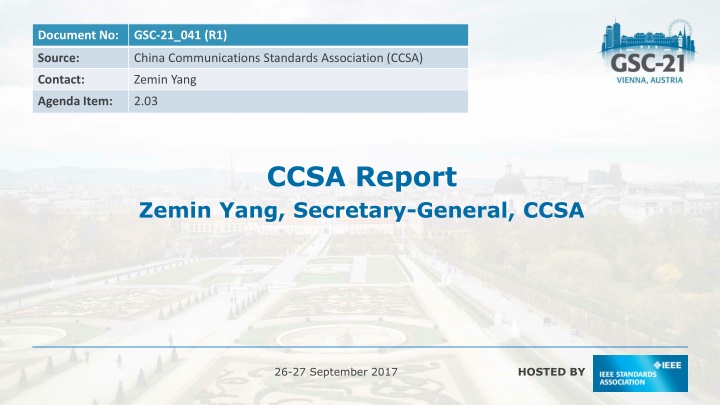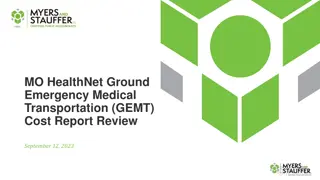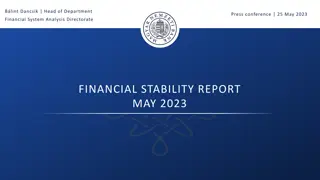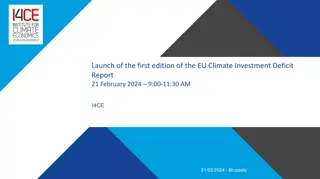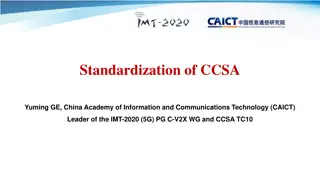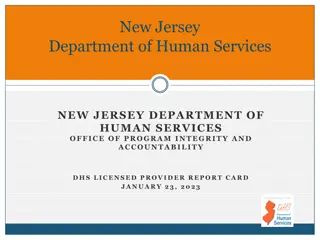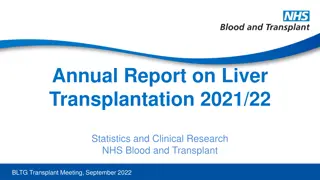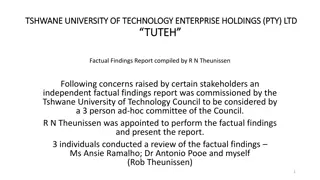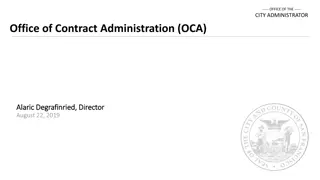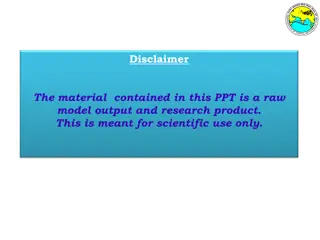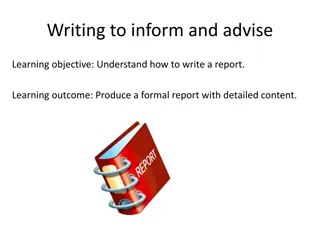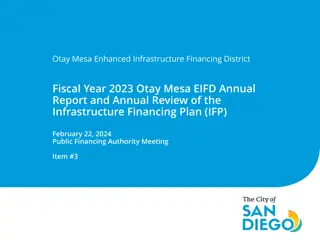CCSA Report
The China Communications Standards Association (CCSA) report details updated activities on 5G, industrial IoT, membership statistics, organizational structure changes, and hot areas of CCSA activities. It includes information on newly established special task groups, adjustments to existing technical committees, and key focus areas such as network security, quantum communication, and green ICT. The report also highlights CCSA's involvement in 5G standardization and collaboration with international standards development organizations.
Download Presentation

Please find below an Image/Link to download the presentation.
The content on the website is provided AS IS for your information and personal use only. It may not be sold, licensed, or shared on other websites without obtaining consent from the author.If you encounter any issues during the download, it is possible that the publisher has removed the file from their server.
You are allowed to download the files provided on this website for personal or commercial use, subject to the condition that they are used lawfully. All files are the property of their respective owners.
The content on the website is provided AS IS for your information and personal use only. It may not be sold, licensed, or shared on other websites without obtaining consent from the author.
E N D
Presentation Transcript
Document No: GSC-21_041 (R1) Source: China Communications Standards Association (CCSA) Contact: Zemin Yang Agenda Item: 2.03 CCSA Report Zemin Yang, Secretary-General, CCSA 26-27 September 2017 HOSTED BY
Contents CCSA updated Activities on 5G Some activities on industrial IoT Deployment 26-27 September 2017 26-27 September 2017 Pg 2 |
CCSA membership 2% 16% 500 474 9% 450 3% 400 60% 271289305324338351358 9% 350 1% 300 Operator IT enterprise Research institute Manufacturer Internet company Channel business Vertical industry Full Member 230 250 109127149148160170184 200 Associate Member Observer 150 100 18% 191225 29 293630 31 35 31 34 32 33 29 50 1912 13 11 8 10 11 10 8 9 11 10 9 13 7 3 0 0 0 82% multi-national company domestic company 26-27 September 2017 26-27 September 2017 Pg 3 |
Changes to CCSA structure Newly established STs/TC: ST7: Quantum Communication and Information Technology Special Task Group ST8: Industrial Internet Special Task Group ST9: Navigation and Location Service Special Task Group Adjustment to existing TCs: The old TC1 and TC3 merged as the new TC3 named Network and Service Capability New TC1 named Internet and Application Technology (working on areas such as data center and cloud computing, and so forth) 26-27 September 2017 Pg 4 |
Organizational Structure in 2017 Newly established STs 26-27 September 2017 Pg 5 |
Hot areas of CCSA activities NGN IoT/M2M applications Industrial Internet Connected Car Connected appliances and Smart home Standards on application side for some industry sectors Network and information security Quantum Communication and Information Technology Blockchain Green ICT 5G SND, NFV IDC, cloud computing 26-27 September 2017 Pg 6 |
Some activities on 5G Standardization Keep pace with activities of ITU and 3GPP on 5G Being part of IMT-2020 Promotion Group of China: draw and coordinate the efforts of Chinese ICT industry and cooperate with international SDOs Test and verification Test and verification on key technology & product under R/D Plans and specifications for test and certification In house test & field trial (30 base stations and 6 venders so far) Spectrum planning Reflects industry's requirements and thoughts on 5G spectrum Assists the gov t with 5G spectrum planning above and below 6GHz 26-27 September 2017 Pg 7 |
China 5G Evaluation Work Plan No.27 (Jun.) 2017 No.28 (Oct.) No.30 (Jun.) 2018 No.31 (Oct.) No.26 (Feb.) No.29 (Jan.) No.32 (Jul.) 2019 No.33 (Dec.) No.34 (Feb.) No.35 (Jun.) 2020 No.36 (Oct.) Evaluation method Step 3 : Submission&Reception of RITs and SRITs Step 4: Evaluation of candidate RITs and SRITs by Independent Evaluation Groups Rel-16 Rel-15 Updates on 3GPP SE 3GPP Self Evaluation 1st 2nd Submission Submission ChEG preliminary results 4 ChEG final results 5 Internal coordination for evaluation submission to 3GPP 2 Establishment of Chinese Evaluation Group (ChEG) No.27 (Jun.) 2017 No.28 (Oct.) No.31 (Oct.) No.26 (Feb.) No.29 (Jan.) No.32 (Jul.) 2019 No.33 (Dec.) No.34 (Feb.) No.35 (Jun.) 2020 No.36 (Oct.) No.30 (Jun.) 2018 1 3 Evaluation on possible 3GPP updated technical features Consideration/evaluation on major technical features and configuration 26-27 September 2017
View and Progress on 5G Spectrum China 5G Spectrum Need estimated by IMT-2020 PG Low-frequency bands (< 6GHz) are the core bands for 5G systems to guarantee connectivity, coverage, mobility and capacity High-frequency bands (> 6GHz) are suitable for high traffic off-loading in hotspot areas. *24.25-43.5 GHz for Micro scenario can also be reused in indoor hotspot China s 5G Spectrum Plan Goes A Big Step Forward in Recent Days On June 5, MIIT posted a draft of initial 5G spectrum plan, where 3300-3600 MHz and 4800-5000 MHz are opened as IMT-2020 frequency bands with the following requirements. 3300-3400 MHz is used for indoor in principle, but can be used outdoor if it does not cause interference to the existing radiolocation service stations In 3300-3600 MHz, IMT-2020 systems should not cause interference to FSS and satellite telemetry In 4990-5000MHz, IMT-2020 systems should not cause interference to radio astronomy service. On June 8, MIIT posted a call for proposals on 5G mmWave frequency bands, including 24.75-27.5GHz, 37- 42.5GHz bands, and other millimeter wave bands. The feedback deadline is August 7, 2017. 26-27 September 2017 Pg 9 |
5G Network Deployment in China 2018 2019 2020 Scale Trial Pre-commercial Trial Commercial Deployment Standalone offers larger scale economies and higher performance for long-term development 5G Core Higher performance via innovative technologies Larger scale economies for the entire life cycle of 5G Accelerate the maturity of 5G product and industry Avoid the complexity of 4G/5G integration Save the total migration cost from 4G to 5G Standalone 5G NR with 5G Core 5G NR UE Non-standalone is an option to meet early service demand in some scenarios Anchored in LTE with Legacy S1 interface Attach to EPC network 5G Core NG EPC S1 Anchored in LTE with NG RAN-CN interface Attach to 5G core network S1 NG LTE eLTE NR NR Xx Xx Pg 10 | 26-27 September 2017
5G R&D Trials of China Promote the R&D of 5G key technologies, technical solutions, and global unified standards, accelerate the development of 5G products, and build 5G ecosystem 2020 2015 2016 2017 2018 2019 Step 1: Key tech trial Phase 1: Technology R&D Trial Step 2: Tech scheme trial Phase 2: Product R&D Trial Step 3: System trial Operator Research Equipment Instrument Chipset Broad Joint test specifications Multi-vendor interoperability Integration with vertical industries participators 26-27 September 2017 Pg 11 |
Summary and Outlook Building Globally Unified 5G Standards and Ecosystem In the framework of globally unified 5G standards, synchronously promote the study of eMBB and IoT standards via technical innovation Actively promote 5G low-frequency planning & allocation, 5G high- frequency planning study, and global harmonization Use 5G trial as a carrier to support 5G technology R&D, standardization, industrialization, and commercialization in 2020 Enhance the research and practice on 5G vertical applications, especially in requirements, technical solutions, business model, and industrial ecosystem. 26-27 September 2017 Pg 12 |
Activities on IoT industrial Employment IoT Indstr Employ -ment 26-27 September 2017 Pg 13 |
Engaged in activities related with all aspects of standards in IoT domain Appliances Household Automotive .....XYZ...... Power ? ...XYZ... ...XYZ... ...XYZ... ISO/IEC Application layer Common blocks oneM2M Connection layer Common blocks XYZ... IEEE 3GPP ITU 26-27 September 2017 Pg 14 |
Some minor standards on application side These standards(protocals), in terms of technologies, are not complex Automobile Appliances Household .....XYZ...... With no major IPR issues Power ? Yet hard to harmonize They may affect the widespread commercialization of certain applications With stds sufficiently converged, the commercialization of chips becomes feasible The complexity of cross-industry multi-stakeholders issues makes it hard to converge this kind standards Working mechanism issues should be considered ...XYZ... ...XYZ... ...XYZ... ...XYZ... Application layer Common blocks oneM2 M Connection layer Common blocks XYZ... IEEE 3GPP ITU 26-27 September 2017 Pg 15 |
The formation mechanism of standards in IoT application side: ICT in Charge Features of the mechanism ICT ecosystem Verticals are weak in our Eco and very often, when they don t like our idea, they vote with foot (just won t use such stds) Our objectives FA_SWG CCSA Menbership Sufficiently converged stds that would be practically used by the industries other sectorss Not necessarily perfect works Special mechanisms may be needed 26-27 September 2017 Pg 16 |
A virtual Client/Server model The 2 parties: United virticals of a few & many ICT Co.s as the majority The procedure Membership @CCSA.TC11.FA_SWG 1. The clients party (united) raises basic requirements and tentative solutions 2. The server party (multiple) offers suggestions on improvement 3. The clients considers the offers and works out a new draft of solutions 4. The server party offers further (if any) solutions on improvement 5. Repeat step 3 and 4 if necessary, until 6. The clients party makes the final decision Aiming for dredging the whole channel to the success of a real business A virtical Co. A ICT Co. 26-27 September 2017 Pg 17 |
Comparison of some possible models in this case Model 1: The classical working model of ICT-SDOs Model 2: What CCSA tried in this case Model 3: Vertical-industry-in-charge model Model 4: A best practice project with one or a few virticals in charge A vertical Co. An ICT Co. CCSA Menbership ICT in charge Virtical in charge A project Charged by a few Vtcs Vtc in charge 26-27 September 2017 Pg 18 |
? The industrial IoT deployment and the way we have relative standards created might show a colourful complexity Should we need adjust ourselves and get used to this 26-27 September 2017 Pg 19 |
Thank you For more information, please contact: Zemin Yang Email address: Yangzemin@ccsa.org.cn Affiliation Name: Affiliation url 26-27 September 2017 Pg 20 |
